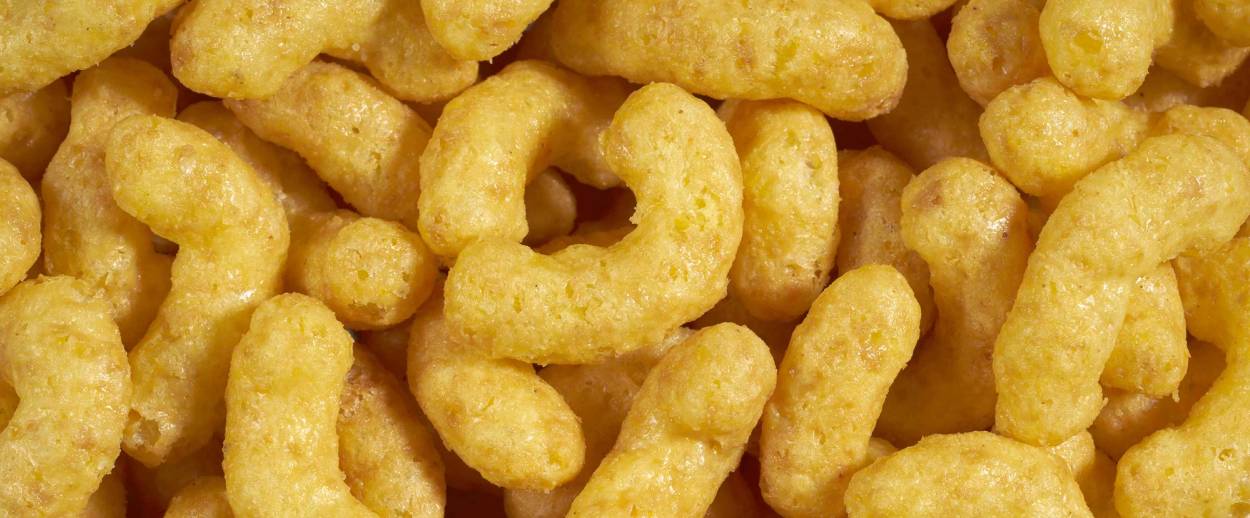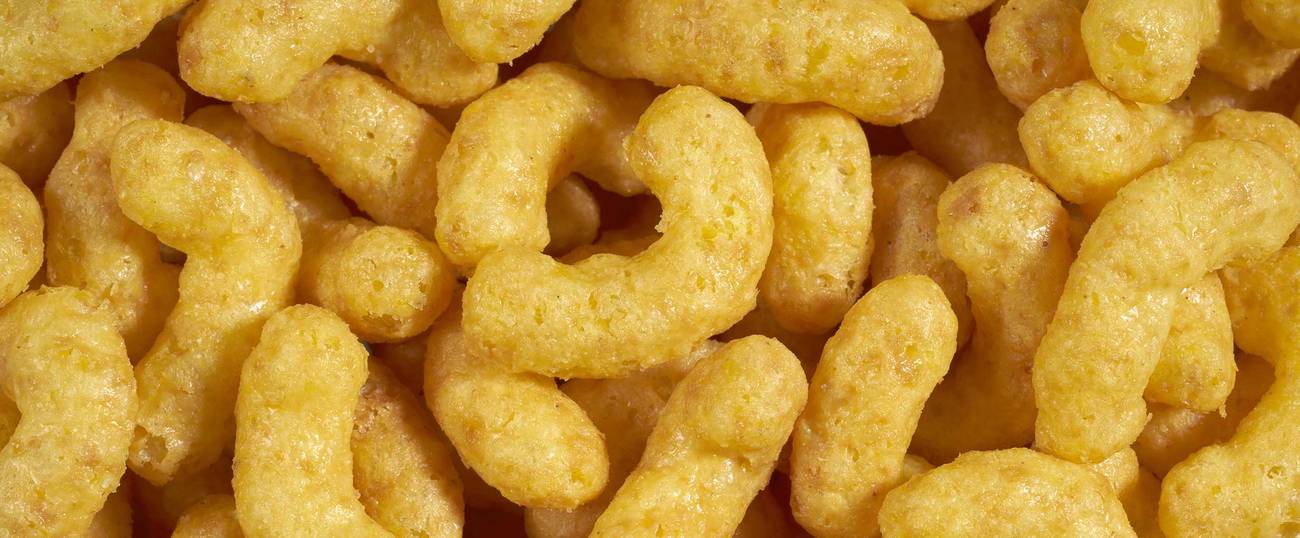Israelis Go Nuts for Bamba
The story behind the country’s beloved snack food




Once, when I entered the local grocery store with my eldest son when he was less than 1 year old, he pointed up from his stroller and demanded, loud and clear: “Bamba!” This is how I found out that daycare professionals feed kids things behind their parents’ backs. This is also how I found out that kids have a way of demanding what they want. And in Israel, they want Bamba.
Bamba is Israel’s most popular savory snack-in-a-bag. According to statistics provided by Osem, the company that manufactures it, Israelis consume close to 10 million bags of Bamba—per month.
For anyone who’s not familiar with Bamba, Yom Ha’atzmaut—Israeli Independence Day, which starts this year on May 1—is the perfect time to get acquainted with this uniquely Israeli treat.
Bamba bits look like short, chubby, yellow worms. They’re not sweet, but they’re not very salty, either; they’re not very crunchy, but they’re not exactly soft. They stick to your teeth, and they taste like peanut butter.
Bamba is a kids’ snack; according to Osem, even the name was chosen because it sounds like baby talk, and can be one of the first words a baby utters: “Ima, Aba, Bamba.” Parents buy it on the way to the playground to keep their young ones happy—and it keeps them happy, too, by appealing to their sense of nostalgia, since they probably grew up eating it themselves. Health-freak moms, the kind who carry raisins in a Ziploc bag, don’t voluntarily offer it to their kids (even though studies show that giving babies peanut products may prevent peanut allergy), but even they know it could be much worse: It’s cheap, it’s available, and probably not too bad on the health-junk divide; it’s made from natural ingredients, without preservatives or food coloring. Plus, holding a bag of Bamba teaches kids to share.
But Bamba isn’t only for kids. Adults who grew up elsewhere might find it an acquired taste—I made aliyah with my family when I was 9, and I must admit that it took me a while to get used to the taste of Bamba—but native-born Israelis feel that Bamba has the taste of Israel. That’s why Israeli backpackers trotting around the globe always try to score some. The yellow snack appears on the cover of Israel’s leading hip-hop group Hadag Nahash’s third album, and there was a local ’90s indie band called the Bamba Paradox, alluding to the myth that Bamba in a large bag tastes different than Bamba in a small bag.
“Bamba is undoubtedly the snack that best reflects Israeli taste,” Galit Milo, Osem snacks activity manager, told me. “For 50 years now, it is the star of every event and is eaten by everybody—toddlers, kids, teenagers, soldiers and grownups, too.”
Bamba has been through a lot of changes since it was introduced in 1964. In its first incarnation, it was cheese-flavored. This might make sense for Americans because Bamba visually resembles cheese puffs, but in Israel, it wasn’t very successful. The following year, four more flavors were added: peanut, corn, caraway, and “grill.” Only the peanut flavor survived more than a year. Peanut-flavored Bamba, which today is regarded as the classic “regular” Bamba, became a hit. Its popularity grew in soldier’s kiosks and canteens around the time of the Six-Day War, and the soldiers then brought Bamba home to their families.
Bamba grew so big that it became a generic term for similar snacks manufactured by competing companies, such as Parpar (manufactured by Telma), Shush (made by Strauss), and a Palestinian version called Azka, manufactured by Hebron-based Qasrawi. There is even an organic version of Bamba, available in health-food stores next to the kale chips, called Cheeky Monkey. But the original Bamba is described as a peanut snack—Osem claims it contains 50 percent peanuts—while some of its competitors are described as “peanut-flavored snacks,” and don’t actually contain a whole lot of peanuts.
In 1993, Bamba’s mascot was born—a cartoon baby with an orange lock of hair on his forehead, a big blue diaper, and an annoying voice—and became something of a cultural icon, staring not only in Bamba commercials but also in children’s DVDs, toys, and computer games. The Olympic Committee of Israel initially picked Bamba’s baby as Israel’s mascot for the London 2012 Summer Olympics, but it was eventually disqualified for being a commercial character.
Osem started making sweet strawberry-flavored Bamba, known in Israel as “Red Bamba” (it is, indeed, colored red, using beetroot rather than artificial coloring) in 1980. But over the past decade, more and more new flavors of Bamba started popping up. In 2008, Osem introduced nougat-cream-filled Bamba as a limited-edition product for Israel’s 60th birthday, but it was such a success that it became a permanent product, sitting on supermarket shelves next to the original.
Afterward, other varieties were invented, like Bamba with halva cream filling and Bamba with–believe it or not–Bamba-cream filling. For a brief moment, there was even Bamba filled with nougat cream and Pop Rocks, and a special-edition frozen Bamba sold only in cinemas. Then there was Bamba-bomba (the size of the actual bits was larger), Bambini (smaller), round Bamba, square Bamba, wheel-shaped Bamba, gluten-free Bamba, and half-and-half Bamba (half of the pieces are filled with one flavor and half with another, like punch and banana or mocha and vanilla).
***
Bamba is not universally beloved in Israel. “I think that Bamba is disgusting,” Shiri Katz, food writer for Time Out Tel Aviv, told me bluntly. “I certainly don’t believe that Bamba is healthy or good for you, added vitamins or not,” she added, noting that she didn’t give the snack to her own children when they were growing up.
Israeli parenting writer and author Ariel Kars slammed Bamba as “junk food with no nutritional value,” noting that it’s high in salt, fat, and calories, and contributes to cavities by sticking to kids’ teeth. Even the nostalgia that some parents feel, said Kars, is primarily something that corporations play up to woo consumers. “Whoever wants to give their kids a healthy snack,” Kars said, “should give them a plate of sliced vegetables and olive oil.”
Clearly, lots of Israeli parents disagree. Personally, my belief is: Everything in moderation. Obviously, I don’t want my kids to eat too much Bamba—so I always help them finish the bag.
Children ages 5 and up (and their parents) can participate in a guided tour at the Bamba visitor center at the factory where it’s made in Holon, just south of Tel Aviv. This factory has been making Bamba since the 1960s, and will continue to do so until sometime next year, when its operations will be relocated to Kiryat Gat, in the south of Israel. The Bamba that is made here is marketed in Israel, as well as in the U.S., Canada, Russia, Brazil, Germany, Brazil, and various other countries around the world—with exports rising each year.
About 30,000 people—locals as well as tourists—visit the Bamba factory every year for tours in Hebrew or English, which can be booked in advance.
Five years after learning to say “Bamba,” this spring my (now 6-year-old) son finally got the full Bamba experience, which included sitting on Bamba-shaped pillows while feasting on endless bowls of the yellow stuff and hearing explanations of how Bamba is made. Later on, the tour took us inside the actual factory (the kids wore miniature hairnets and smocks), and it all finished with a screening of a 3-D animation film featuring Bamba’s baby mascot, and a visit from a man inside a creepy Bamba-baby-suit.
Guess what the kids got to take home at the end of the tour.
***
Like this article? Sign up for our Daily Digest to get Tablet Magazine’s new content in your inbox each morning.
Dana Kessler has written for Maariv, Haaretz, Yediot Aharonot, and other Israeli publications. She is based in Tel Aviv.